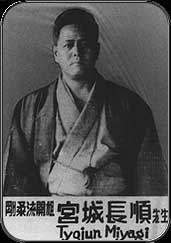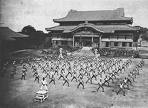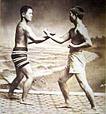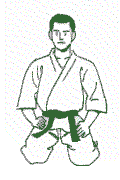History of Karate-do







The first public demonstration of karate in Japan was in 1917 by Gichin Funakoshi, at the Butoku-den in Kyoto (Hassell 1984). This, and subsequent demonstrations, greatly impressed many Japanese, including the Crown-Prince Hirohito, who was very enthusiastic about the Okinawan art. In 1922, Dr. Jano Kino, founder of the Japanese art of Judo, invited Funakoshi to demonstrate at the famous Kadoka Dojo and to remain in Japan to teach karate. This sponsorship was instrumental in establishing a base for karate in Japan. As an Okinawan "peasant art," karate would have been scorned by the Japanese without the backing of so formidable a martial arts master (Maliszewski, 1992).
Today there are four main styles of karate-do in Japan: Goju-ryu, Shito-ryu, Shotokan, and Wado-ryu:
Goju-ryu developed out of Naha-te, its popularity primarily due to the success of Kanryo Higaonna (1853-1915). Higaonna opened a dojo in Naha using eight forms brought from China. His best student, Chojun Miyagi (1888-1953) later founded Goju-ryu, 'hard soft way' in 1930. In Goju-ryu much emphasis is placed on combining soft circular blocking techniques with quick strong counter attacks delivered in rapid succession.
Shito-ryu was founded by Kenwa Mauna (1889-1952) in 1928 and was influenced directly by both Naha-te and Sheri-te. The name Shinto is constructively derived from the combination of the Japanese characters of MaunaÂ’s teachers' names - Ankh Its and Kanryo Higaonna. Shito-ryu schools use a large number of Kata, about fifty, and is characterized by an emphasis on power in the execution of techniques.
Shotokan was founded by Gichin Funakoshi (1868-1957) in Tokyo in 1938. Funakoshi is
considered to be the founder of modern karate. Born in Okinawa, he began to study karate with Yasutsune Azato, one of Okinawa's greatest experts in the art. In 1921 Funakoshi first introduced Karate to Tokyo. In 1936, at nearly 70 years of age, he opened his own training hall. The dojo was called Shotokan after the pen name used by Funakoshi to sign poems written in his youth. Shotokan Karate is characterized by powerful linear techniques and deep strong stances.
Wado-ryu, 'way of harmony', founded in 1939 is a system of karate developed from jujitsu and karate by Hienori Otsuka as taught by one of his instructors, Gichin Funakoshi. This style of karate combines basic movements of jujitsu with techniques of evasion, putting a strong emphasis on softness and the way of harmony or spiritual discipline.
A Brief History of Goju-Ryu
The art of Naha-te, founded by Kanryo Higaonna Sensei, forms the basis of Goju Ryu Karate. Kanryo Higaonna Sensei was born in 1853 and was part of the lower gentry. He longed to study in China the art of Chinese Kempo, however, was lacking in financial means until he was introduced to the owner of a ship. Fortunately, the owner granted him passage and Kanryo Higaonna Sensei soon arrived at the port city of Foochow, the only city in China engaged in trade with Okinawa at that time. Eventually, he was introduced to Master Ryu Ryuko. Kanryo Higaonna Sensei spent sixteen years in Foochow, China, studying under Master Ryu Ryuko and become like a son to him. He also became well known throughout the region as a great martial artist. Upon his return to Okinawa, Kanryo Higaonna Sensei paid his respects to the owner of the ship, Yoshimura, and began teaching his sons the art he had learned. As the word spread of his great skill, he soon also taught members of the royal family. Later he opened his own dojo. Kanryo Higaonna Sensei was especially known for his incredible speed, strength and power and his art became known as Naha-dee (te). (See Kanryo Higaonna Sensei Profile)
The actual founder of the Goju Ryu karate was Miyagi Chojun Sensei, a personal disciple of Kanryo Higaonna Sensei. At the age of 14, Miyagi Chojun Sensei met Kanryo higaonna Sensei and together they devoted their lives to the improvement and advancement of the art of Naha-te. They spent thirteen years together until Kanryo Higaonna Sensei passed away in 1916. Miyagi Chojun Sensei?s family was part of the gentry. They owned two trading ships that imported medicine from China for both the government and private individuals. The same year Kanryo Higaonna Sensei died, Miyagi Chojun Sensei left for China to discover the roots of Naha-te in the city of Foochow. Unfortunately, all had fled during the revolutionary war and he returned to Okinawa. Miyagi Chojun Sensei was a man of strong will and excelled in his studies. He trained daily, often with nature in harsh elements, and practiced various exercises to develop his senses. He created several katas and sometimes would receive instructions from his dreams.
In addition to his personal training and development of Naha-te, Miyagi Chojun Sensei spent a great deal of his time promoting the art. In 1921, he performed a demonstration of Naha-te in Okinawa for the visiting Prince Hirohito, Emperor of Japan, and in 1925 for Prince Chichibu. Miyagi chojun Sensei had already envisioned the development of Naha-te not only in Japan but also around the world. It became increasingly important to organize and unify Okinawan karate as a cultural treasure to be passed on to future generations. In 1926, Miyagi Chojun Sensei established the Karate Research Club in Wakas-Cho. Four instructors, Miyagi Chojun, Hanashiro, Motobu and Mabuni, taught alternately some preliminary exercises and supplemental exercises. Afterwards, Miyagi Chojun Sensei gave talks to the students about mankind, daily life, and the samurai code of ethics in order to improve their moral development as well. In 1927, Kano Jigoro Sensei, founder of Judo, saw a demonstration of a kata by Miyagi Chojun Sensei and was impressed by the advanced technique and sophistication of Naha-te. Kano Sensei?s influence allowed Miyagi Chojun Sensei to perform Okinawan karate at leading Japanese Budo tournaments sponsored by the government. In 1930, Miyagi Chojun Sensei performed at the Butoku-kai Tournament and at the Sainei Budo Tournament in 1932.
As its exposure increased, many became interested in Miyagi Chojun Sensei?s art. One of Miyagi Chojun Sense?s senior disciples, Shinzato Sensei, gave a performance of kata at a Japanese martial arts tournament. Afterwards, a master asked the name of his school. Shinzato Sensei had no answer for him, returned to Okinawa and told Miyagi Chojun Sensei about his encounter. In order to promote his art as well as cooperate with other schools of Japanese martial arts, Miyagi Chojun Sensei decided it was necessary to name his art. It became known as ?Goju Ryu? Karate, meaning ?hard and soft? taken from the precepts of traditional Chinese Kempo (see below). He was the first among different schools of karate to name his art and in 1933 his art of Goju Ryu was formally registered at the Butoku-kai, Japanese Martial Arts Association.
During the 1930?s, Miyagi Chojun Sensei actively developed and promoted karate-do in Japan and throughout the world. For example, in 1934, a Hawaiian newspaper company invited him to Hawaii in order to introduce and populate karate in Hawaii. In 1936, Miyagi Chojun Sensei spent two months in Shanghai, China, for further study of Chinese martial arts. In 1937, he was awarded a commendation by the Butoku-kai for his kata. Miyagi Chojun Sensei developed Goju Ryu by analyzing and employing scientific methods of exercise. In 1940, he created katas ?Gekisai Dai? ichi? and ?Gekisai Dai? ni? with the purpose of popularizing karate and improving the physical education of young people. He also created ?Tensho? kata emphasizing the softness of the art whereas ?Sanchin? kata emphasizes the hardness.
A tragic period ensued in the 1940?s as a result of World War II and Miyagi Chojun Sensei stopped teaching. During this period he lost a son and a senior student while enduring the devastations of war and poverty. After the war, Okinawan karate spread rapidly throughout mainland Japan. Miyagi Chojun Sensei taught karate in Kansai, Japan, for a short time. In 1946, however, he started teaching karate at the Okinawan Police Academy as well as in the backyard of his home in Tsuboya where his son still lives today.
From the beginning, Miyagi Chujun Sensei recognized karate as a valuable social treasure of Okinawa. He devoted his entire life to the study, development and transmission of Okinawan karate for the sake of future generations and is truly known as the founder of Goju Ryu karate-do. During his lifetime, Miyagi Chojun Sensei was known and respected by everyone not only in Okinawa but also respected throughout the world as one of karates greatest authorities.
Miyagi Chojun Sensei chose the name 'Goju Ryu' from the 'Eight Precepts' of traditional Chinese Kempo found in the document 'Bubishi' and are as follows:
1.The mind is one with heaven and earth.
2.The circulatory rhythm of the body is similar to the cycle of the sun and the moon.
3.The way of inhaling and exhaling is hardness and softness.
4.Act in accordance with time and change.
5.Techniques will occur in the absence of conscious thought.
6.The feet must advance and retreat, separate and meet.
7.The eyes do not miss even the slightest change.
8.The ears listen well in all directions.
These eight precepts are the essence of the martial arts and are the elements one strives to achieve in training Goju Ryu Karate-do. Such training shall serve to lead humankind to rediscover our natural instincts and capabilities.
“Oss,”
The Karate Greeting
One doesn’t have to be around a karate dojo very long before hearing this word pass between members. Students and instructors alike will commonly bow to each other upon meeting, or as class is about to begin, and say oss. But what exactly does it mean?
In Japanese the word oss is written as a two-character combination. The first
character means “to push,” and the second means “to suffer.” Together they symbolize the importance of pushing, striving and persevering while suffering through whatever difficulties, pains and hindrances are encountered along the way. So, at the literal level, oss is simply an affirmation of the positive attitude, high spirits and refusal to quit that all karate people seek to develop as they train.
On a deeper and more general level it might be translated as “keep the faith,” in the sense of karate philosophy and goals. And, finally, it serves as a greeting expressing warm respect and friendship, the Japanese
Sometimes students who do not clearly understand the meaning of this word will use it incorrectly.
For example, it is not usually used as an affirmative remark to signify
agreement, in the same way that hai (“yes”) or wakarimasu (“I understand”) might be used. Nor should it be shouted out as a kiai word while executing strikes and kicks.
Should it be used by parents of students when greeting instructors or students?
In practice, anyone who supports the goals of karate and has an interest in learning about it may appropriately greet karateka, if they wish, with a bow and an oss, as a sign of respect and admiration for what they do.
Alternatively, the good old smile-and-a handshake are equally acceptable.